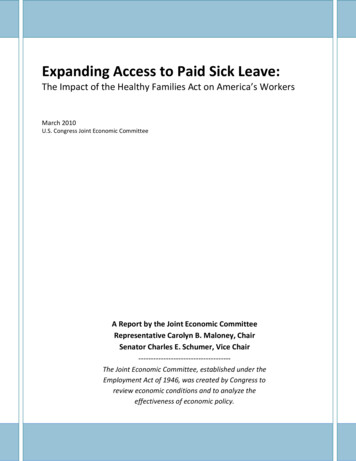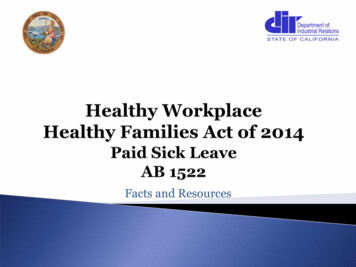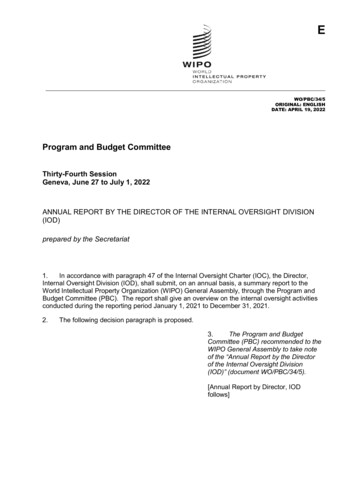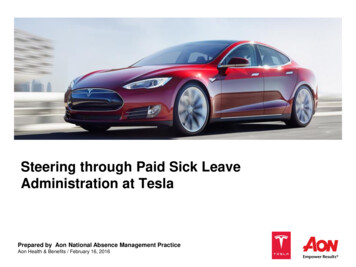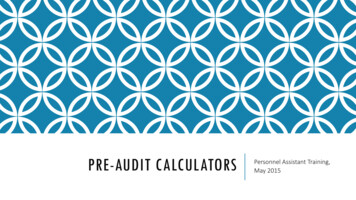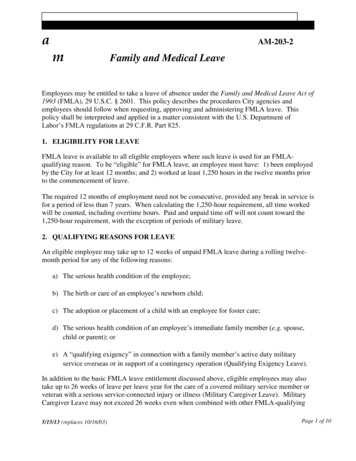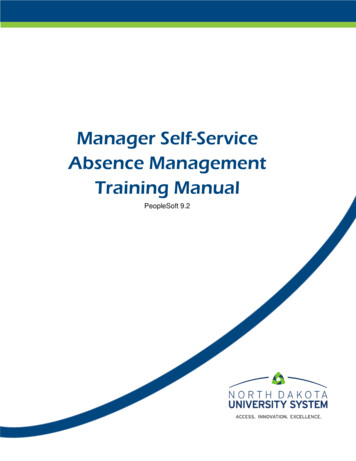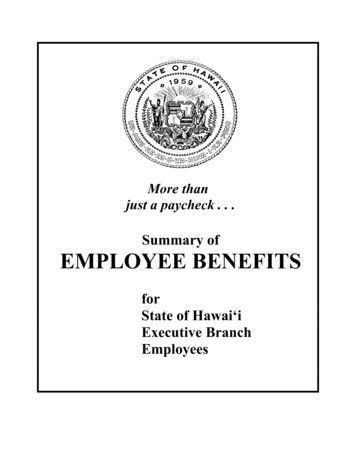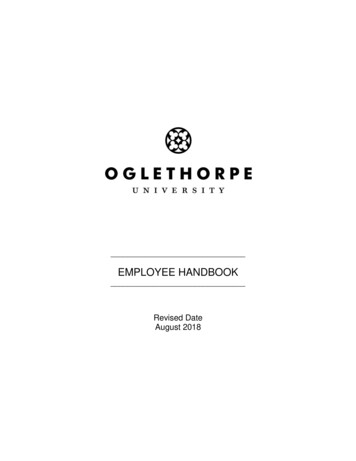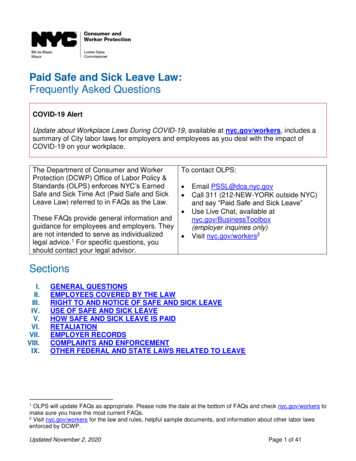
Transcription
Paid Safe and Sick Leave Law:Frequently Asked QuestionsCOVID-19 AlertUpdate about Workplace Laws During COVID-19, available at nyc.gov/workers, includes asummary of City labor laws for employers and employees as you deal with the impact ofCOVID-19 on your workplace.The Department of Consumer and WorkerProtection (DCWP) Office of Labor Policy &Standards (OLPS) enforces NYC’s EarnedSafe and Sick Time Act (Paid Safe and SickLeave Law) referred to in FAQs as the Law.To contact OLPS: These FAQs provide general information andguidance for employees and employers. Theyare not intended to serve as individualizedlegal advice.1 For specific questions, youshould contact your legal advisor. Email PSSL@dca.nyc.govCall 311 (212-NEW-YORK outside NYC)and say “Paid Safe and Sick Leave”Use Live Chat, available atnyc.gov/BusinessToolbox(employer inquiries only)Visit IX.GENERAL QUESTIONSEMPLOYEES COVERED BY THE LAWRIGHT TO AND NOTICE OF SAFE AND SICK LEAVEUSE OF SAFE AND SICK LEAVEHOW SAFE AND SICK LEAVE IS PAIDRETALIATIONEMPLOYER RECORDSCOMPLAINTS AND ENFORCEMENTOTHER FEDERAL AND STATE LAWS RELATED TO LEAVE1OLPS will update FAQs as appropriate. Please note the date at the bottom of FAQs and check nyc.gov/workers tomake sure you have the most current FAQs.2 Visit nyc.gov/workers for the law and rules, helpful sample documents, and information about other labor lawsenforced by DCWP.Updated November 2, 2020Page 1 of 41
I.GENERAL QUESTIONS1. When do employers have to start complying with the Law?The Law went into effect on April 1, 2014. The Law was amended twice: May 5, 2018: Safe leave provisions took effect.September 30, 2020: Amendments to expand safe and sick leave and to bring the Lawin line with New York State law requirements took effect.2. What is sick leave?Sick leave is time off work for health reasons. Covered employees can use sick leave for thecare and treatment of themselves or a family member.3. What is safe leave?Safe leave is time off work for safety reasons. Covered employees can use safe leave to seekassistance or to take other safety measures if the employee or a family member is the victim ofany act or threat of domestic violence, unwanted sexual contact, stalking, or human trafficking.4. Who is considered a family member under the Law?The Law has a broad definition of family member that includes the following: Child (biological, adopted, or foster child; legal ward; child of an employee standingin loco parentis)Spouse (current or former, and regardless of whether they reside together)Domestic Partner (current or former, and regardless of whether they reside together)3ParentChild or parent of an employee’s spouse or domestic partnerGrandchild or grandparentSibling (half, adopted, or step sibling)Any other individual related by blood to the employeeAny other individual whose close association with the employee is the equivalent of afamily relationship5. Which employers must provide safe and sick leave?Private, nonprofit, and household employers that employ workers in NYC must provide safe andsick leave.Employers with 4 or fewer employees: must provide up to 40 hours of unpaid safe and sick leave if the employer’s net income isless than 1 million in the previous tax year.(as of January 1, 2021) must provide up to 40 hours of paid safe and sick leave if theemployer’s net income is 1 million or more in the previous tax year.A “domestic partner” is a person with a domestic partnership registered under Section 3-240 of the New York CityAdministrative Code. For more information about the requirements and procedure for registering as domesticpartners, visit the Office of City Clerk website at cityclerk.nyc.gov3Updated November 2, 2020Page 2 of 41
Employers with 5 or more employees regardless of net income: must provide up to 40 hours of paid safe and sick leave if the employer employs up to100 employees.(as of January 1, 2021) must provide up to 56 hours of paid safe and sick leave if theemployer employs 100 or more employees.o Employees may accrue up to 56 hours of paid safe and sick leave as ofSeptember 30, 2020 but are not entitled to use hours 41-56 until January 1, 2021.Employers of domestic workers: must provide up to 40 hours of paid safe and sick leave if the employer employs up to100 employees.(as of January 1, 2021) must provide up to 56 hours of paid safe and sick leave if theemployer employs 100 or more employees.6. Are nonprofit employers covered by the Law?Yes. Nonprofit employers are covered by the Law and must comply with its requirements.7. How is employer size determined?Employers should count all employees who work for pay on a full-time, part-time, seasonal, ortemporary basis.Employers that have operated for less than one year: Employers should count the number of employees performing work for pay per week.If the number fluctuates, employer size may be determined for the current Calendar Yearbased on the average number of employees per week who worked during the 80 daysimmediately preceding the date the employee used safe and sick leave.Employers that have operated for one year or more: Employers should count the number of employees working for the employer per week atthe time the employee used safe and sick leave. If the number of employees fluctuatedbetween less than five employees and five or more employees three times in the mostrecent calendar quarter, employer size may be determined for the current CalendarYear based on the average number of employees per week during the previousCalendar Year.8. What does “Calendar Year” mean?Under the Law, “Calendar Year” means any consecutive 12-month period of time as determinedby an employer. Most employers will find it helpful to use the same “Calendar Year” that theyuse for calculating wages and benefits, such as: tax year, fiscal year, contract year, the yearrunning from an employee’s anniversary date of employment, or the year running from January1 to December 31.Note: Employers must include their Calendar Year in the written Notice they must giveemployees. See Section III, starting with FAQ 12.Updated November 2, 2020Page 3 of 41
9. If the employer is part of a chain business and/or has multiple locations, whichemployees count toward the number of employees?If a business has multiple locations and the owner or principal of the multiple locations owns atleast 30% of each location and each location is either engaged in the same business oroperates under a franchise agreement as defined under New York State law, then the totalnumber of employees should include employees at all locations in New York City as long as themultiple locations collectively employ at least five employees.4Scenarios:Kenny, an employer, owns 50% of each of three pizzerias in New York City.Each location employs four employees. Would Kenny have to provide paidor unpaid safe and sick leave?Kenny must provide paid safe and sick leave to his employees. Kenny shouldcount all 12 employees toward the number of employees.Silvia owns 25% of one fast food restaurant, which is operated under afranchise agreement with a franchisor. There are 50 other locations of thisfranchise in New York City. Silvia employs four workers at her restaurant.Would Silvia have to provide paid or unpaid safe and sick leave?Silvia must provide unpaid safe and sick leave to her employees. Silvia ownsless than 30% of one franchise, the restaurant is not part of a group of locationsthat share a common owner or principal who owns at least 30% of eachestablishment, and Silvia employs fewer than five employees.Possible exception as of January 1, 2021:If Silvia’s net income is 1 million or more in the previous tax year, then, startingJanuary 1, 2021, Silvia must provide paid safe and sick leave to her employees.10. Do employees who do not live in New York City count toward the number ofemployees?Yes. The Law applies to employees employed in New York City. For counting purposes, it doesnot matter where the employees live.11. Does an employer based outside of New York City have to provide safe and sick leaveto employees who work in New York City?Yes. Employers located outside New York City must provide safe and sick leave to employeeswho work in New York City.Go to ag.ny.gov and search “Franchisors and Franchisees” or consult Section 681 of the New York State GeneralBusiness Law for more information.4Updated November 2, 2020Page 4 of 41
Scenarios:Sara owns a trucking company based in Buffalo. Her drivers make regulardeliveries and pickups in New York City. Are Sara’s drivers working in NewYork City for purposes of the Law?Yes. Making deliveries or pickups in New York City is performing work in NewYork City.Boss Trucking Company is based in Cleveland. Its drivers drive throughNew York City without stopping to make deliveries or pickups. Are Boss’sdrivers working in New York City for purposes of the Law?No. Drivers who pass through New York City without stopping to make pickups,deliveries, or otherwise work in New York City are not considered to be workingin New York City for purposes of the Law, which does not apply to employeeswho do not work in New York City.12. Can an employee have more than one employer?Yes. Two or more employers may be a “joint employer” of an employee, with each having somecontrol over the employee’s work or working conditions. Joint employers may be separate anddistinct individuals or entities with separate owners, managers, and facilities.Example: A general contractor and its subcontractor may be joint employers of employees onthe same construction project.13. If employers are joint employers, which employer is responsible for compliance withthe Law?Generally, each joint employer is responsible, jointly and severally, for compliance with allapplicable provisions of the Law and payment of any relief and penalties for violations ofthe Law.Example: If a franchisor employer exercises some control over the work or working conditionsof a franchisee’s employees, both the franchisee and franchisor may be considered jointemployers of the employees under the Law and have an obligation to ensure that itsrequirements are met.14. What factors are considered in determining whether an employer is a joint employer?Whether an employer is a joint employer of the employee is based on an assessment of theemployer’s exercise of control over the work or working conditions of an employee. Factors thatare considered include but are not limited to whether:i.ii.iii.iv.v.The employer established policies or practices related to the employment, supervision,and/or working conditions of the employee.The employer has the power to hire and fire the employee.The employer supervises and controls the employee’s work schedule or conditionsof employment.The employer determines the rate and method of payment.The employer maintains the employee’s employment records.Updated November 2, 2020Page 5 of 41
vi.vii.viii.ix.The employee uses the employer’s premises and equipment.The employee performs discrete work that is integral to the employer’s productionor work.The employee works exclusively or predominantly for the employer.The employer provides training to the employee.15. How should joint employers count the employees they jointly employ?Every employer that is a joint employer must count each employee jointly employed indetermining the number of employees who work for pay.Example: An employer who jointly employs three workers and also has three employees underits sole control has six employees for the purposes of the Law and must provide paid safe andsick leave to each employee.Example: An employer employs four workers through a temporary help firm as well as threepermanent workers who are employed directly and under the employer’s sole control. Thatemployer has seven employees for purposes of the Law and must provide paid safe andsick leave.16. If an employee has two or more joint employers, does the employee accrue separateleave balances with each employer for the same work?No. If an employee is employed by two or more joint employers, all of the employee’s work foreach of the joint employers will be considered as a single employment for purposes of accrualand use of safe and sick leave under the Law.Scenario:Maria is a garment worker employed by a contractor (ABC Corp.) thatcontracts with a manufacturer (XYZ Corp.) to assemble garments. ABCCorp. and XYZ Corp. are joint employers of Maria. How is Maria covered bythe Law?All of the hours Maria works assembling garments for both ABC Corp. and XYZCorp. are counted as a single employment and, together, her joint employersmust provide safe and sick leave, which she accrues at a rate of 1 hour for every30 hours she works.Maria does not maintain two different balances of accrued safe and sick leave,one each with ABC Corp. and XYZ Corp.17. What is a temporary help firm?A temporary help firm is an organization that recruits and hires its own employees and assignsthose employees to perform work or services for another organization to:i.ii.iii.support or supplement the other organization’s workforce;provide assistance in special work situations, such as employee absences,skill shortages, or seasonal workloads; orperform special assignments or projects.Updated November 2, 2020Page 6 of 41
A placement firm that does not hire employees on its own behalf would not meet the definition oftemporary help firm.II.EMPLOYEES COVERED BY THE LAW1. Which employees are covered by the Law?Most employees who work in New York City are covered by the Law, including: Full-time employeesPart-time employeesDomestic workersTemporary and seasonal employeesPer diem and on-call employeesTransitional jobs program employeesUndocumented employeesEmployees who are family members but not ownersEmployees who live outside of New York City but work in New York CityOwners who are considered employees under New York State Labor Law2. Which employees are not covered by the Law?The Law does not apply to: Government employees (federal, State of New York, City of New York)Participants in federal work-study programs5Employees whose work is compensated by qualified scholarship programs as defined in26 U.S.C. § 1176Hourly professional employees who:i.are licensed by the New York State Education Department under Sections 6732,7902, or 8202 of the New York State Education Law;ii.call in for work assignments, at will, to determine their work schedule with the abilityto reject or accept any assignment referred to them; andiii.are paid an average hourly wage which is at least four times the federal minimumwage for hours worked during the Calendar Year.Independent contractors who do not meet the definition of an employee under New YorkState Labor Law7Certain employees subject to a collective bargaining agreementParticipants in Work Experience Programs (WEP) under Section 336-c of the New YorkState Social Services LawOwners who do not meet the definition of an employee under New York State Labor Law3. Does the Law cover domestic workers?Yes, the Law has always covered domestic workers. However, under new amendments thattook effect on September 30, 2020, domestic workers are now covered the same as private ornonprofit employees working for employers with 5 or more employees.5Information about federal work-study programs is available on the U.S. Department of Education website ed.govFor more information, see the Internal Revenue Code.7 Go to labor.ny.gov and search for “Independent Contractors.”6Updated November 2, 2020Page 7 of 41
Specifically: Domestic workers accrue safe and sick leave at the rate of 1 hour for every 30 hoursworked, up to a maximum of 40 hours per year (or, effective January 1, 2021, up to amaximum of 56 hours per year if their employer employs 100 or more employees).Domestic workers may use safe and sick leave as it is accrued.Domestic workers are workers who provide care, companionship, housekeeping, or any otherdomestic service in a home, whether employed by an agency or a household.Examples: Domestic workers include nannies, housekeepers and house cleaners, and homehealth aides. They may be solely employed or jointly employed, e.g., by a household employerand an agency employer.Domestic workers who are also entitled to days of rest under New York State Labor Law havethese days of rest count toward fulfillment of the City Law requirements only if the days of restare made available on the same terms and conditions as required by City Law. If they are not,then the days of rest are additional days for worker use apart from what City Law provides.4. Does the Law apply to undocumented workers?Yes. All covered workers have the same rights and protections under the Law, regardless ofimmigration status.In addition, DCWP will answer questions and process safe and sick leave complaints withoutregard to immigration status. DCWP will not ask about workers’ immigration status during thecourse of any DCWP investigation.5. Does the Law apply to employees who are based outside New York City but who workin New York City on an occasional basis?Yes. For employees who work in New York City on an occasional basis, the employer mustcalculate safe and sick leave accruals based on the hours that the employee spends working inNew York City.6. Does the Law apply to supervisors, managers, and salaried employees?Yes.7. Does the Law apply to independent contractors?No. The Law applies to employees only.Whether a worker is an employee or independent contractor depends on several factors.These include how much supervision, direction, and control the employer has over theservices being provided.Workers may meet the legal standard for classification as employees even if they areconsidered independent contractors by their employers.Example: Just because an employer issues a 1099 tax form to a worker, has a worker sign acontract stating that the worker is an independent contractor, or rents a workspace to a workerUpdated November 2, 2020Page 8 of 41
(such as a chair in a salon), that does not necessarily mean the worker is actually anindependent contractor.8. If a worker believes that an employer misclassified the worker as an independentcontractor instead of as an employee and, therefore, did not provide safe and sickleave as required by the Law, can the worker file a complaint with DCWP?Yes. Workers who believe they have been misclassified as independent contractors may file acomplaint with DCWP. As part of its investigation, DCWP will make a determination as towhether a worker is covered by the Law.9. Does the Law apply to employees who telecommute?Yes. Employees who telecommute are covered by the Law for the hours when they arephysically working in New York City (on-site or by telecommuting), even if the employer isphysically located outside New York City.Employees are not covered for the hours when they are not physically working in New York City,even if the employer is physically located in New York City.10. Does an employer have to provide safe and sick leave to employees who also work forother unrelated employers?Yes. Assuming that the employee is eligible to accrue safe and sick leave from both employers,both employers must provide the employee with safe and sick leave. This is true even if theemployee works for employers that are not joint employers.11. Does the Law apply to industrial homeworkers?Employees who manufacture industrial goods in their home for an employer are covered by theLaw if they perform their work from a New York City residence, even if the employer isphysically located outside New York City.Employees are not covered by the Law if they perform their work from a residence outside NewYork City, even if the employer is physically located in New York City.12. Does the Law apply to employees covered by collective bargaining agreements?It depends.The Law does not apply to employees covered by a valid collective bargaining agreement thatwas in effect on April 1, 2014 (or in effect before the effective date of subsequent amendmentsto the Law) until that collective bargaining agreement expires. For employees covered by acollective bargaining agreement, the Law does not apply if:i.ii.the collective bargaining agreement expressly waives the Law's provisions; andthe agreement provides a comparable benefit to employees, such as paid time off.If both of these conditions are not in place, the Law does apply to these employees.Exception: For employees in the construction or grocery industries covered by a collectivebargaining agreement that came into effect after April 1, 2014 (or after the effective date ofsubsequent amendments to the Law), the Law does not apply if the collective bargainingUpdated November 2, 2020Page 9 of 41
agreement expressly waives the Law's provisions. The agreement does not have to provide acomparable benefit to these employees.III.RIGHT TO AND NOTICE OF SAFE AND SICK LEAVE1. For what purposes can a covered employee use sick leave?Employees can use sick leave to take time off from work when: They have a mental or physical illness, injury, or health condition; need to get a medicaldiagnosis, care, or treatment of a mental or physical illness, injury, or health condition;or need to get preventive medical care.They must care for a family member who needs medical diagnosis, care, or treatmentof a mental or physical illness, injury, or health condition, or who needs preventivemedical care.Their employer’s business closes due to a public health emergency or they need to carefor a child whose school or child care provider closed due to a public health emergency.2. Can an employee use sick leave for doctor, dentist, or eye doctor appointments?Yes. Employees may use sick leave for appointments when they require treatment for acondition or for preventive medical care.3. What is preventive medical care?Preventive medical care is routine health care that includes screenings, checkups, and patientcounseling to prevent illnesses, disease, or other health problems.84. For what purposes can a covered employee use safe leave?Covered employees can use safe leave if they or a family member may be the victim of any actor threat of domestic violence, unwanted sexual contact, stalking, or human trafficking, and theyneed to take actions necessary to restore the physical, psychological, or economic health orsafety of themselves or family members, or to protect those who associate or work with theemployee, including to: 8Obtain services from a domestic violence shelter, rape crisis center, or otherservices program.Participate in safety planning, relocate, or take other actions to protect theemployee’s safety or that of the employee’s family members, including enrollingchildren in a new school.Meet with an attorney or social service provider to obtain information and advicerelated to custody; visitation; matrimonial issues; orders of protection; immigration;housing; discrimination in employment, housing, or consumer credit.File a domestic incident report with law enforcement or meet with a districtattorney’s office.Attend civil or criminal court dates related to any act or threat of domestic violence,unwanted sexual contact, stalking, or human trafficking.For examples of preventive care for adults, women, and children, visit the federal website HealthCare.govUpdated November 2, 2020Page 10 of 41
5. Can an employee use safe leave even if the employee has not reported a crime to thepolice and/or if the crime has not been proven?Yes. The Law does not require an employee to prove that a crime has occurred or beenreported in order to use safe leave. Employees may use safe leave if they or a family membermay be the victim of acts or threats of acts that may constitute the specified crimes under NewYork State Penal Law.6. What is a family offense matter?Family offense matters include: any threat or act of physical violence between family members;any threat or act of sexual assault or abuse by a family member;any threat or act of theft of money, property, or items of value among members of thesame household.7. What is human trafficking?Human trafficking includes threats or acts that may constitute sex trafficking and labortrafficking.A victim of sex trafficking has been coerced into prostitution involuntarily due to narcoticsubstances or other drugs; to pay a real or perceived debt; because someone withheld ordestroyed government or immigration identification like visas or passports; through violence,threats, or lies; or any other coercive means defined in the New York State Penal Law.A victim of labor trafficking has been coerced into labor to pay a real or perceived debt; becausesomeone withheld or destroyed government or immigration identification like visas or passports;through violence, threats, or lies; or any other coercive means defined in the New York StatePenal Law.8. What is a sexual offense?A sexual offense is any act, or threat of an act, that may constitute rape, sexual abuse, sexualassault, or other sex offense under the New York State Penal Law.9. What is stalking?Victims of stalking have experienced any act, or threat of an act, that may constitute the crime ofstalking as defined by the New York State Penal Law. The crime of stalking may include: two or more acts with no legitimate purpose which cause victims to fear for the safety ofthemselves or loved ones;verbal, nonverbal, written, direct, or indirect threats which cause victims to fear for theirsafety or the safety of loved ones;a course of conduct, including following, telephoning, or contacting the victim or victim’sfamily member, meant to cause reasonable fear of harm to the victim or victim’s family’sproperty, employment, or person.The perpetrator of the crime of stalking may be known to the victim or may be a stranger.Updated November 2, 2020Page 11 of 41
Actions that have a legitimate purpose—for example, letters from a debt collector seekingpayment on a valid debt—do not constitute stalking without other facts suggesting the sender’sintent to cause harm.10. What are some examples of safe leave?Someone from Ruby’s neighborhood has been following her. Recently, someonebroke into her apartment while she and her 10-year-old son were out. No one wasphysically harmed, but Ruby suspects that it was the person who has beenfollowing her and she doesn’t feel safe staying in her neighborhood anymore.She has decided to move in with her mom in another school district. Ruby needsto take a day off from work to enroll her son in his new school and to move theirbelongings to storage and her mom’s apartment. May Ruby use safe leave?Yes. Ruby is taking time off from work to move and to enroll her son in a new schoolbecause the acts against her are some of the acts that can constitute the crime ofstalking. Stalking and threats or acts that may constitute stalking are covered by theLaw; covered employees may use safe leave to relocate and to enroll children in a newschool. Ruby’s employer must provide safe leave.Warren was mugged one early Sunday morning, a workday, after dropping off hispartner at the airport. He needs to take a couple of hours off to go to the policestation to identify suspects. Is the time Warren needs to take off safe leave?No. Although Warren was the victim of a violent crime, it was not an act or threat ofdomestic violence, unwanted sexual contact, stalking, or human trafficking. Hisemployer is not required to provide him with leave under the Law. The Law, however,does not prohibit his employer from giving him time off to handle the police matter.Francisco needs to take a half-day to go to court to obtain a restraining orderagainst his son-in-law who used to live with him and assaulted Francisco. Is thetime Francisco needs to take off from work safe leave?Yes. Francisco is attending a court proceeding to protect himself and his family after afamily offense matter. His employer must provide safe leave.Jennifer, a salesclerk, is pickpocketed on the subway on her way to work and herwallet is stolen. She believes the perpetrator may have watched her withdrawingmoney from the ATM and followed her into the subway station. She immediatelyfiles a report with a law enforcement officer, causing her to be an hour late towork. Can Jennifer use safe leave for this time?No. Pickpocketing is not an act or threat of domestic violence, unwanted sexualcontact, stalking, or human trafficking. Although in this case Jennifer may have beenfollowed into the subway station, it’s unlikely that the one-time incident, withoutevidence of a pattern or practice, constituted “stalking.”Donna, a paralegal, has been receiving counseling from her pastor after adomestic violence incident involving her ex-boyfriend. She needs to take theafternoon off work to attend a counseling session. May Donna use safe leave forthis time?Yes. Donna was the victim of a family offense matter and is meeting with her pastor inorder to improve her psychological health. This would be considered a permissible useof safe leave.Updated November 2, 2020Page 12 of 41
11. Does safe leave provide more time off for employees, over and above sick leave?No. The Law does not require employers to provide separate safe and sick leave to employees.Instead, employers must provide at least one form of leave that employees can use for eithersafe or sick leave purposes.12. Are employers required to give employees notice of their right to safe and sick leave?Yes. Employers must give covered employees a written Notice of Employee Rights. Employersmust also post the Notice in the workplace in an area that is visible and accessible toemployees. The Notice must be posted by January 1, 2021.Employers must give a written Notice of Employee Rights to employees when they beginemployment or when their rights change. Employees have a right to be given a Notice in Englishand, if available on the DCWP website, their
Updated November 2, 2020 Page 3 of 41 Employers with 5 or more employees regardless of net income: must provide up to 40 hours of paid safe and sick leave if the employer employs up to 100 employees. (as of January 1, 2021) must provide up to 56 hours of paid safe and sick leave if the employer employs 100 or more employees.

